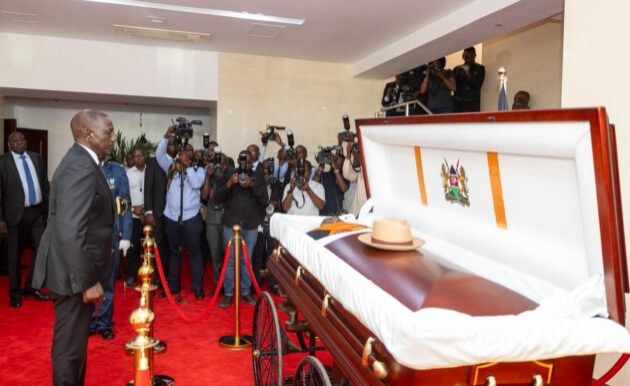Nairobi — The chaotic scenes that erupted at Jomo Kenyatta International Airport (JKIA) on Thursday during the arrival of former Prime Minister Raila Odinga’s remains from Mumbai, India, have laid bare Kenya’s glaring lack of preparedness to handle large crowds and safeguard critical installations during high-profile national events.
What began as a solemn occasion quickly devolved into a full-blown security crisis, as thousands of emotional supporters breached airport security and flooded restricted areas — including the runway — despite the presence of elite security units, the Presidential Escort, and senior government officials.
Not even the deployment of special forces drawn from the Kenya Defence Forces, National Police Service, and the President’s security detail could deter the surging crowd from invading one of the country’s most heavily guarded facilities.
Keep up with the latest headlines on WhatsApp | LinkedIn
In an unprecedented lapse, hundreds of motorcyclists — normally barred from entering airport grounds — rode freely into JKIA, with some reaching the airside where the Kenya Airways aircraft carrying Odinga’s body had landed.
Even with President William Ruto and top officials present to receive the body, the crowd’s surge proved unstoppable.
The President, who had been scheduled to officially receive the casket, was unable to access the plane and only managed to view the body later at Kasarani Stadium, where another wave of disorder marred the proceedings.
Airspace closure
The Kenya Civil Aviation Authority (KCAA) was forced to temporarily close airspace over JKIA between 10.26 am and 12.26 pm to facilitate emergency rescreening and restore order.
“This essential measure is to facilitate an enhanced security rescreening operation following the arrival of the remains of the late Rt. Hon. Raila Odinga, former Prime Minister of Kenya,” said Mohamud Gedi, Acting Managing Director and CEO of the Kenya Airports Authority (KAA)
“The safety and security of our passengers, staff, and all airport users is our highest priority. This action reflects our unwavering commitment to maintaining the highest security standards.”
Gedi expressed regret over the inconvenience caused but defended the decision as a necessary precaution to uphold both national security and aviation safety.
Passengers with scheduled flights during the closure were advised to contact their airlines for updates.
The disorder extended to Kasarani Stadium, where Odinga’s body was later taken for public viewing.
3 dead
At least three people were reported dead and several others injured after police fired live rounds and lobbed tear gas to disperse crowds attempting to force their way into the VIP section.
Chaos erupted shortly after 3.00 pm when frustrated supporters, angered by long delays, surged past barriers and hurled objects at security officers.
The ensuing pandemonium sent mourners fleeing for safety as tear gas filled the terraces and concourses. National Youth Service (NYS) personnel administered first aid before evacuations were carried out.
The Interior Cabinet Secretary was captured on video pleading with officers to stop using tear gas on mourners. At one point, he and Principal Secretary Raymond Omollo were seen negotiating with police to calm the situation — a moment that highlighted the lack of coordination among security agencies.
The confusion was mirrored at Parliament Buildings, where sections of the crowd moving from the airport overpowered guards and damaged the Senate gate, forcing a last-minute change of plans for the official public viewing. The event, initially scheduled for Parliament, was relocated to Kasarani due to security concerns.
Death in India
Odinga, who died on October 15 in Kochi, India, at the age of 80, had been undergoing medical treatment and Ayurvedic therapy when he collapsed during a morning walk. Doctors at Devamatha Hospital were unable to revive him despite extensive efforts.
A towering figure in Kenyan politics, Odinga’s death has triggered an outpouring of grief and reflection across the nation and beyond. The government declared a week of national mourning, with flags flying at half-mast.
President Ruto led State Funeral at Nyayo National Stadium ahead of his burial on Sunday at his rural home in Bondo, Siaya County.
Following Thursday’s chaotic scenes in Nairobi, leaders in Kisumu have appealed for calm as Odinga’s body is expected to arrive in the lakeside city on Saturday for public viewing and an overnight vigil in Bondo.
Call for clam in Kisumu
Speaking during a media briefing, Nyanza Regional Commissioner Flora Mworoa and Kisumu Governor Prof. Anyang’ Nyong’o urged residents to maintain peace and order, saying a dignified farewell would best honour Odinga’s legacy.
“The Regional Commissioner has said very clearly that people in this region love peace,” Governor Nyong’o said. “Let that be proven on Saturday.”
Mworoa added: “We ask everyone to be very peaceful. This is the time to show the world the dignity with which we celebrate one of our own.”
Authorities in Kisumu said preparations are complete, with enhanced coordination between national and county teams.
“We are ensuring all security arrangements are in place,” said Nyong’o, noting that public advisories on access and movement will be issued ahead of the procession.
Kisumu — long the heartbeat of Odinga’s political base — is expected to receive tens of thousands of mourners.
Local leaders have urged discipline amid reports that many youths plan to spend Friday night near Jomo Kenyatta International Sports Stadium (Mamboleo) to await the cortege.
“This is your day,” Nyong’o told the youth. “Don’t spoil it. Let us send off our hero in peace.”


